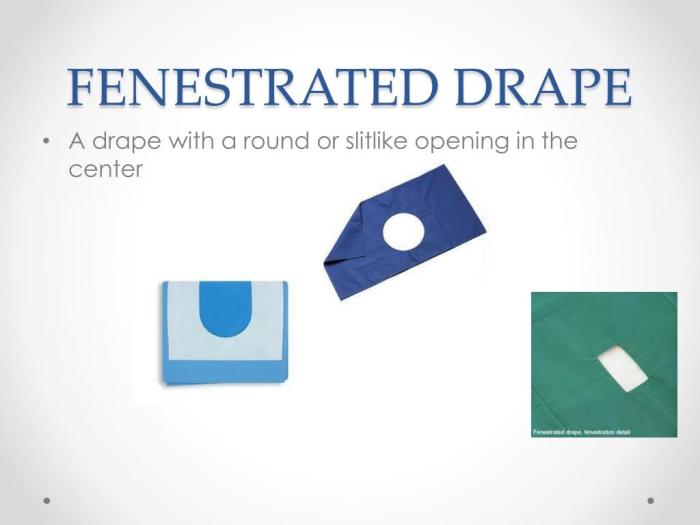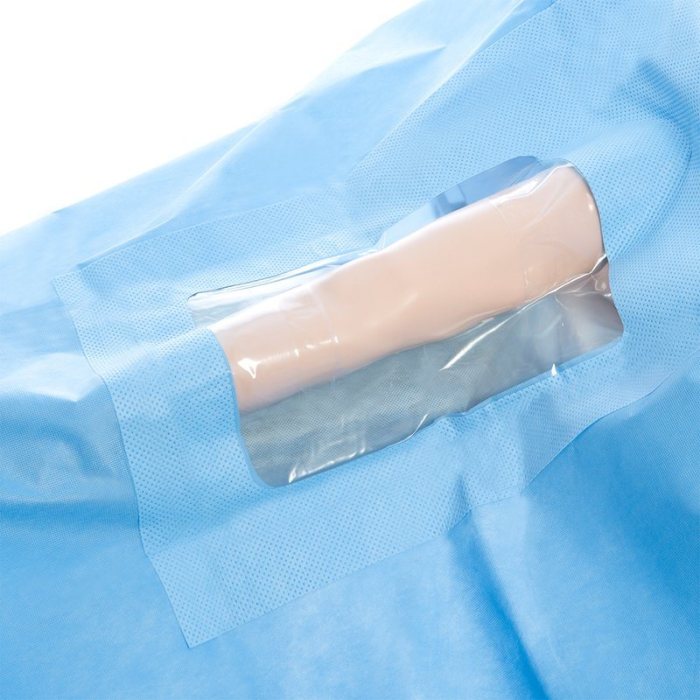Fenestrated vs non fenestrated drape – In the realm of window treatments, fenestrated vs. non-fenestrated drapes stand as distinct choices, each offering unique advantages and applications. Embark on an enlightening journey as we delve into the intricacies of these draperies, exploring their materials, designs, and practical considerations.
Fenestrated drapes, adorned with intricate cutouts, allow for a harmonious interplay of light and privacy, while non-fenestrated drapes provide a solid barrier, offering complete light control. Understanding these nuances is crucial for selecting the perfect drapery solution for any space.
Definitions

A fenestrated drape is a type of curtain or window treatment that has openings or cutouts, allowing light and air to pass through while still providing some privacy. Non-fenestrated drapes, on the other hand, are solid curtains or window treatments that do not have any openings or cutouts.
Examples of fenestrated drapes include sheer curtains, lace curtains, and voile curtains. Examples of non-fenestrated drapes include blackout curtains, velvet curtains, and damask curtains.
Materials

Fenestrated drapes are typically made from lightweight, sheer fabrics such as cotton, linen, or silk. These fabrics allow light to pass through while still providing some privacy. Non-fenestrated drapes, on the other hand, are typically made from heavier, more opaque fabrics such as velvet, damask, or blackout fabric.
These fabrics block out light and provide more privacy.
The choice of material for a drape will depend on the desired level of light and privacy, as well as the overall style of the room.
Design: Fenestrated Vs Non Fenestrated Drape

Fenestrated drapes typically have a more delicate and airy appearance than non-fenestrated drapes. They can be used to add a touch of elegance to a room, and they can also be used to create a more open and airy feel.
Non-fenestrated drapes, on the other hand, have a more solid and opaque appearance. They can be used to block out light and provide more privacy, and they can also be used to create a more formal and sophisticated look.
Applications
Fenestrated drapes are ideal for rooms where you want to let in some light while still maintaining some privacy. They are also a good choice for rooms where you want to create a more open and airy feel.
Non-fenestrated drapes are ideal for rooms where you want to block out light and provide more privacy. They are also a good choice for rooms where you want to create a more formal and sophisticated look.
Installation
Fenestrated drapes are typically easier to install than non-fenestrated drapes. They can be hung from a curtain rod or track, and they do not require any special hardware.
Non-fenestrated drapes, on the other hand, may require more hardware to install. They may need to be hung from a curtain rod or track, and they may also need to be lined with blackout fabric to block out light.
Maintenance
Fenestrated drapes are typically easier to clean than non-fenestrated drapes. They can be machine washed and dried, and they do not require any special care.
Non-fenestrated drapes, on the other hand, may require more care to clean. They may need to be dry cleaned, and they may also need to be lined with blackout fabric to block out light.
Cost
Fenestrated drapes are typically less expensive than non-fenestrated drapes. They are made from lighter, less expensive fabrics, and they do not require any special hardware to install.
Non-fenestrated drapes, on the other hand, are typically more expensive than fenestrated drapes. They are made from heavier, more expensive fabrics, and they may also require special hardware to install.
Trends
The current trend in drapes is towards fenestrated drapes. These drapes are more airy and open, and they can help to create a more modern and contemporary look.
Non-fenestrated drapes are still popular, but they are more likely to be used in formal settings. They can help to create a more traditional and sophisticated look.
Answers to Common Questions
What is the primary distinction between fenestrated and non-fenestrated drapes?
Fenestrated drapes feature cutouts that allow light to pass through, while non-fenestrated drapes are solid and block light completely.
Which type of drape is better suited for bedrooms?
Non-fenestrated drapes are ideal for bedrooms as they provide complete darkness for optimal sleep.
How do I choose the right material for my drapes?
Consider factors such as durability, light-filtering properties, and ease of maintenance when selecting the material for your drapes.